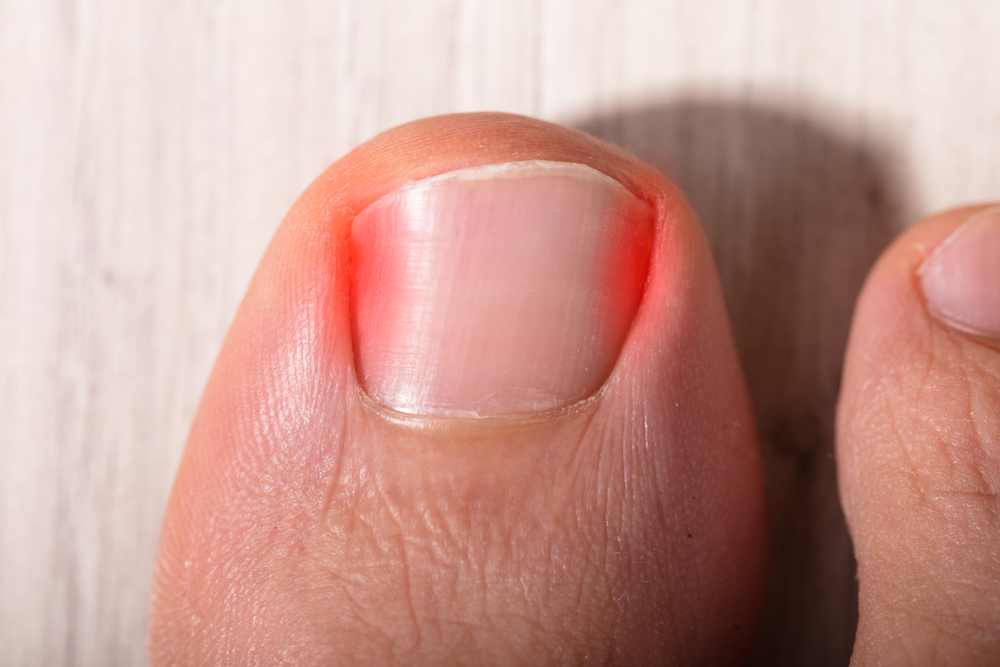Connect With Us
Blog
Items filtered by date: April 2021
What Are Bunions?
 Bunions are a common foot disorder characterized by the appearance of a bony bump on the side of the foot at the base of the big toe. Bunions grow slowly due to pressure on the joint of the big toe. This pressure causes the big toe to move out of place and lean toward the other toes. Bunions can be the result of genetics, lifestyle factors, or a combination of both. Wearing shoes that are too tight, high heels, or shoes that have a narrow toe box may create bunions as well. Some people are naturally predisposed to developing bunions, and their risk may increase if they wear ill-fitting shoes. Certain foot conditions, such as arthritis and flat feet, can also make bunions more likely. Without treatment, bunions tend to worsen and grow larger causing severe pain and discomfort, making it difficult to wear shoes. If you have developed a bunion it is recommended that you see a chiropodist for treatment.
Bunions are a common foot disorder characterized by the appearance of a bony bump on the side of the foot at the base of the big toe. Bunions grow slowly due to pressure on the joint of the big toe. This pressure causes the big toe to move out of place and lean toward the other toes. Bunions can be the result of genetics, lifestyle factors, or a combination of both. Wearing shoes that are too tight, high heels, or shoes that have a narrow toe box may create bunions as well. Some people are naturally predisposed to developing bunions, and their risk may increase if they wear ill-fitting shoes. Certain foot conditions, such as arthritis and flat feet, can also make bunions more likely. Without treatment, bunions tend to worsen and grow larger causing severe pain and discomfort, making it difficult to wear shoes. If you have developed a bunion it is recommended that you see a chiropodist for treatment.
Bunions progressively worsen over time and may cause walking in your shoes to become difficult. To learn more about bunions, please consult with Paul A. Scotti, D.Ch of West Toronto Foot & Ankle Clinic Inc. Our chiropodist will assess your condition and provide you with quality foot and ankle treatment.
What Are Bunions?
A bunion is a bony bump that protrudes from the base of the big toe. Bunions are caused due to a misalignment of the first metatarsal. The characteristic bump of a bunion forms when the metatarsal shifts outwards from its proper position. Bunions develop slowly over time and progressively worsen without treatment. The skin over the bunion may develop calluses due to the friction from shoes. Eventually, a bunion can make walking uncomfortable or even painful. Bunions are one of the most common foot deformities and are especially common in women and older adults.
Symptoms
A bunion appears as a bulging bump on the outside of the base of the big toe.
The bunion may also:
- Be swollen, red, or sore
- Develop corns or calluses over it
- Cause pain
- Limit the big toe’s range of motion
Treatment
There are several different treatments available for bunions. Conservative treatment options include wearing shoes with a wider toe box, cushioning the bunion with a specialized pad, wearing shoe inserts, icing the bunion if it becomes inflamed, and taking medications to relieve pain. In more severe cases, surgery can be an option. Surgical procedures for bunions may involve removing the swollen tissue around the bunion, straightening the big toe, realigning the bones at the front of the foot, or a combination of these procedures.
If you have any questions, please feel free to contact our office located in Toronto, ON. We offer the newest diagnostic and treatment technologies for all your foot care needs.
Be Free of Toenail Fungus for Spring
What Causes Ingrown Toenails?
 Ingrown toenails are a common condition in which the outer edge of a toenail grows into the surrounding skin. This typically occurs on the big toe, and can cause pain, swelling, and redness in the affected area. Ingrown toenails can be caused by wearing tight, ill-fitting shoes, shoes with pointed toes, and shoes with high heels, which can compress the toes and force the toenails to curve into the skin. Trimming the toenails improperly can also cause them to grow into the skin. Toenails should be trimmed straight across, without rounding the edges of the nail. Injury to the toenail, fungal infections, taking certain medications, and having an irregular nail shape can also lead to ingrown toenails. If you suffer from painful ingrown toenails or are prone to them, it is recommended that you seek the care of a chiropodist.
Ingrown toenails are a common condition in which the outer edge of a toenail grows into the surrounding skin. This typically occurs on the big toe, and can cause pain, swelling, and redness in the affected area. Ingrown toenails can be caused by wearing tight, ill-fitting shoes, shoes with pointed toes, and shoes with high heels, which can compress the toes and force the toenails to curve into the skin. Trimming the toenails improperly can also cause them to grow into the skin. Toenails should be trimmed straight across, without rounding the edges of the nail. Injury to the toenail, fungal infections, taking certain medications, and having an irregular nail shape can also lead to ingrown toenails. If you suffer from painful ingrown toenails or are prone to them, it is recommended that you seek the care of a chiropodist.
Ingrown toenails may require medical attention. If you have significant pain or notice signs of infection from an ingrown toenail, please consult with Paul A. Scotti, D.Ch of West Toronto Foot & Ankle Clinic Inc. Our chiropodist will assess your condition and provide you with quality foot and ankle treatment.
What Is an Ingrown Toenail?
An ingrown toenail occurs when the edges of a toenail grows into the surrounding skin. Usually the toenails of the big toe are affected, however, an ingrown toenail can happen on any toe. Sometimes, the area can become infected leading to potentially serious complications. The ingrown toenail may be caused by improper trimming of the toenail, wearing ill-fitting shoes, or injury to the nail.
Symptoms
The symptoms of an ingrown toenail include:
- Pain
- Swelling
- Redness
- Warmth
- Pus or drainage from the affected nail or a fever may indicate an infection of the area.
Treatment
Treatment depends on the severity of the ingrown toenail. In less severe cases, home treatment may be adequate. Soaking the affected foot in warm water and gently lifting the nail from the skin with a piece of clean cotton can help. In more severe cases, you may need to use topical or oral antibiotics to treat an infection. Surgical removal of the ingrown toenail may be required if more conservative treatments fail.
Ingrown toenails may be prevented by wearing well-fitted shoes and properly trimming the toenails. Toenails should be trimmed straight across and not too short when using nail clippers.
If you have any questions, please feel free to contact our office located in Toronto, ON. We offer the newest diagnostic and treatment technologies for all your foot care needs.
Blog Archives
- November 2025
- October 2025
- September 2025
- August 2025
- July 2025
- June 2025
- May 2025
- April 2025
- March 2025
- February 2025
- January 2025
- December 2024
- November 2024
- October 2024
- September 2024
- August 2024
- July 2024
- June 2024
- May 2024
- April 2024
- March 2024
- February 2024
- January 2024
- December 2023
- November 2023
- October 2023
- September 2023
- August 2023
- July 2023
- June 2023
- May 2023
- April 2023
- March 2023
- February 2023
- January 2023
- December 2022
- November 2022
- October 2022
- September 2022
- August 2022
- July 2022
- June 2022
- May 2022
- April 2022
- March 2022
- February 2022
- January 2022
- December 2021
- November 2021
- October 2021
- September 2021
- August 2021
- July 2021
- June 2021
- May 2021
- April 2021
- February 2021
- January 2021

